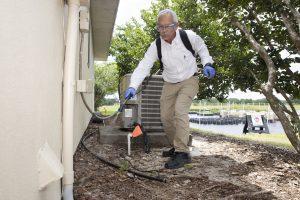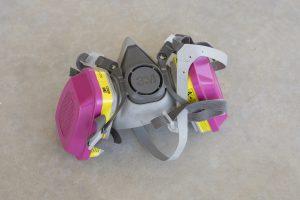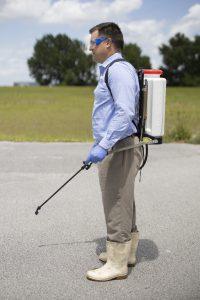Hello Avid Readers! Welcome back to our series for Pesticide Safety Education Month! This, the second blog of our 2023 series, will teach applicators how to assemble a PPE kit. However, it is VERY IMPORTANT to note that there is no such thing as “basic” or “standard” PPE. Applicators must always check the label in advance to ensure they have what they need. That being said, there are several PPE items that are frequently required by pesticide labels and are always good to have around. Let’s discuss what each of these are and why they are important.
What PPE Do I Need?
This question is best answered by reading the label of the product you are using. I wrote a blog last year that will help you find this information. The label is specifically catered to the individual product and the unique risks posed by that product. It is the law to wear all PPE listed on the label. Additional PPE, while not required, can always be worn at the applicators discretion. So what are some common items listed on labels that you might want to make sure you always have on hand or in your “kit”.
Chemical Resistant Clothing
Chemical-resistant clothing can protect applicators from exposure to a variety of products. The level of protection depends on the features of the clothing. The label may not be very specific so consider the type of fabric, presence of flaps over zippers, and items with elastic at the wrists and ankles. Coveralls should be made of sturdy material such as cotton, polyester, or a non-woven fabric such as Tyvek®. When wearing a coverall, the opening should be closed securely so the entire body, except the feet, hands, neck, and head, is covered.
Some product labels require the handler to wear a chemical- resistant suit. This usually indicates the pesticide is very hazardous because of either acute or delayed effects. Chemical-resistant suits made of rubber or plastic are sold as one-piece coveralls or as two-piece outfits consisting of a jacket worn over coveralls. The biggest drawback to chemical-resistant suits is they make the body uncomfortably warm, and in Florida that can be a problem!
An apron can protect from splashes and spills, and it protects coveralls or other clothing. Be sure to read the pesticide label, it may require wearing a chemical-resistant apron when mixing or loading a pesticide or when cleaning application equipment. If an apron is on one of your product labels you should always have one in your vehicle. Some aprons are heavily constructed, but lightweight, disposable aprons are also commercially available. Information on chemical-resistant clothing and aprons cane found in our document EDIS: Personal Protective Equipment for Handling Pesticides
Gloves
The parts of the body that get the most exposure to pesticide are the hands and forearms. Most product labels require use of waterproof or chemical-resistant gloves during handling and mixing. Gloves should be worn any time pesticides may contact hands, such as when working around contaminated equipment or surfaces. Labels will generally state the kind of gloves you should use, but if you need help we have a publication on glove selection too!

Eyewear
Eyes are very sensitive to the chemicals contained in some pesticides, especially concentrates. Goggles, face shields, and safety glasses with shields are examples of protective eyewear. Shielded safety glasses and full-face shields are good choices in many handling situations because they are relatively comfortable, do not cause fogging or sweating, and provide good eye protection.

If goggles will be worn, materials made of polycarbonate that have protected air baffles to avoid fogging are the most comfortable choice. Either goggles or shielded safety glasses can be worn with a half-face respirator. More details on eyewear for your PPE kit can be found in our document on “Protective Eyewear for Pesticide Applicators “.
Respirators
Respirators protect from breathing pesticide-contaminated air. Various pesticide formulations require different types of respirators. The label will provide specific instructions if required, and if so, which type. The National Institute of Occupational Safety and Health (NIOSH) is the federal agency responsible for testing and certifying respirators used in conjunction with pesticides. Approval numbers beginning with the letter TC are assigned to all respirators reviewed by the agency and must be on the box containing the facepiece.

An applicator should perform a fit test to determine correct size of a respirator face piece because a respirator that does not provide a proper seal will not provide the intended protection. OSHA mandates that a fit test be performed every time a person puts on a respirator. Instructions for conducting fit tests generally accompany half- mask and full-face respirators. Respirators can be a confusing but vital piece of PPE. If these are are a part of your PPE kit reach the following article to ensure you are in compliance.
Respirators for Pesticide Applicators
Footwear
Boots may be required by the label. Some applicators choose to wear boots every day both in order to prevent exposure, and to have only one pair of shoes associated with pesticide application. If you choose to wear boots, do not use leather boots. Wear unlined chemical-resistant boots which cover your ankles. Nitrile and butyl boots may give the best protection. If chemical-resistant boots are too hot to wear in warm climates or too difficult to put on, try wearing chemical-resistant overboots with washable shoes (such as canvas sneakers or layered socks.) Remember to put your pant legs outside the boots, otherwise the pesticide can drain into the boot exposing you to pesticides.

Summary
In summary, there is no such thing as “basic” or “standard” PPE. However, the items listed above are often required by labels or beneficial to always have to protect yourself. A good PPE kit can include chemical resistant clothing, eyewear, gloves, footwear, and a respirator. In addition to these common items ensure you always have all the PPE listed on your products’ labels in your vehicle. PPE is no good if it is not maintained well. Come back next week to learn about how to maintain your PPE!
SUBSCRIBE TO OUR BLOG
Additional Resources
 0
0

